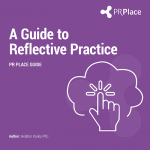Reflection and professional development
Download our free guide to reflective practice.
Download: Guide to Reflective Practice
The guide will help you to:
- Understand what reflection is
- Explore tools and techniques that you can use
- Improve your practice by taking a reflective approach.

We respect your privacy and handle your data with care. Please see our privacy policy.
Thank you for downloading our guide. We hope you find it helpful and enjoyable. We are adding new ones all the time, so check back regularly.
If you asked us to keep you up to date with new guides and the latest industry insights, you will receive an email shortly asking you to verify the address we need to send them to.


